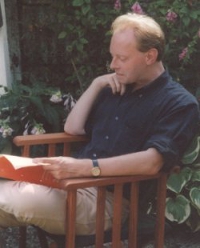Professor Chris Rhodes - Career to Date
Home Page | Blog: Energy Balance | CV | Publications | Media File | Conferment of DSc | University Shambles
Summary
My research/consulting interests concern environmental decontamination and pollutant degradation, nanoporous materials for green chemistry, renewable energy sources and fuels, including fuels made from algae, and the development of sustainable societies.
I am based in Reading in the U.K.
Career to Date
I started my career in industry, spending 4 years in total with Beecham Pharmaceuticals and Wellcome Research. I am a graduate of the University of Sussex, having obtained both my B.Sc and D.Phil there, followed by a 2 year period as a post-doctoral fellow at the University of Leicester with Professor M.C.R.Symons, FRS. Subsequently, I worked for 2 years as a lecturer in Physical Chemistry at Thames Polytechnic, before moving to Queen Mary and Westfield College, University of London, as a lecturer in Organic Chemistry where I remained for 5 years, until being appointed as Research Professor in Chemistry at Liverpool John Moores University in 1994. I was awarded a D.Sc in 2003 by the University of Sussex.
In a five-year period, I was awarded grants totalling £1.4m; additionally central facilities to the value of £4.8m were awarded via competitive peer review.
This support came from: research councils (EPSRC; BBSRC), the Leverhulme Trust, the Wellcome Trust, the Paul Scherrer Institute, industry (Shell Research, Ceram Research, Courtaulds, Akross Chemicals, JEOL Ltd., Bruker Spectrospin, Unilever Research, Convatec), the European Union, NATO, The Royal Society, the Government of China and the International Science and Technology Centre (ISTC, based in Moscow).
In August 2003, I moved down to Reading where I am currently based, and set-up as an independent consultant for energy and the environment, in which capacity I am involved in projects concerning land decontamination, radioactive waste management, antioxidants and free radical toxicology, radiation effects on biomolecules and on satellite components, and a feasibility study of alternative fuels and energy sources based on biomass and algae, and hydrothermal conversion of biomass and algae to biochar, fuels and oil-independent feedstocks for industry. My current funding is from several commercial enterprises, the MoD and the European Commission, for whom I act as an independent expert.
Recent research/consultancy projects
- Zeolites, clays and other nanoporous media in heavy-metal pollution and radioactive waste management.
- Land decontamination from pesticides and chemical waste.
- Radiation effects on biomolecules and on satellite components
- New fuels and alternative energy sources based on biomass and algae.
- Biochar and hydrothermal conversion of biomass and algae to biochar, fuels and petroleum-independent feedstocks for industry.
- Peak oil and the need to develop localised less transport-dependent societies.
- Peak oil and farming with low inputs: permaculture and regenerative agriculture.
- Phosphate recovery from wastewater using algae.
One current environmental project is concerned with using natural zeolites (clinoptilolite) to clean liquid nuclear waste from the Metsamor Nuclear Power Plant in Armenia.
In total around 200 publications have arisen from the successful outcome of these and related activities. One recent paper has received around 800 citations.
The collaboration and support of the Rutherford-Appleton Laboratory and the Paul Scherrer Institute (Switzerland) render possible the development of radiolabelling and time-resolved spectroscopic studies of processes involving radicals, particularly in atmospheric and environmental pollution chemistry. Additional collaborations with PSI concern measuring the diffusion of water in clays to be used for radioactive-waste remediation and hydrothermal biomass (algae) conversion to fuels.
I have given invited plenary lectures at the International Symposium on Radical Ions in Uppsala, the 2nd International Conference of the Polish EPR Association, the 17th International Conference on Radical Ions in Spain, two International Workshops on EPR (EMARDIS) in Sofia (Bulgaria), the International Conference on Spin-Trapping (SPIN) in Kaiserslautern, the 34th International Meeting of the Electron Spin Resonance Group of the Royal Society of Chemistry (University of Bristol) and the keynote lecture at the ISTC Workshop on “Prospective Materials and Devices for Solar Energy and Space Applications,” in Yerevan, Armenia. I have lectured at: the University of Basle, the University of Notre Dame Radiation Laboratories, the Paul Scherrer Institute (Switzerland), the University of Ioannina (Greece), Kocaeli University (Turkey), the University of Leipzig, Texas Tech University, Rice University (Houston), the University of Texas at Arlington, the Slovak Technical University in Bratislava (Slovakia), the University of Constantine the Philosopher in Nitra (Slovakia) the Yerevan Physics Institute and the Yerevan State University (Armenia).
I have given invited lectures at many international conferences and in university departments around the world, and radio and televised interviews, on a range of subjects, and more recently at popular science venues, e.g. Cafe' Scientifique, Science Cafe, University of the third age (U3A, The Women's Institute, on the theme of the depletion of world oil reserves and the necessary development of sustainable, less transport-dependent societies.
Past and current projects, involve groups both in the U.K. and in the wider world. Particular international links are with: Sweden, Germany, Switzerland, USA, Turkey, Greece, Bulgaria, Poland, Slovakia, Italy, Armenia and Russia.
Research Highlights
Using conventional ESR methods:
- monitoring toxic atmospheric particulate matter
- reaction of atmospheric pollutants on reactive surfaces present in the atmosphere
- use of spin-probes in studies of pesticide and radioactive-waste absorption by soils
- studies of electron transfer agents in environmental remediation
- activation of pollutants in atmospheric aerosols by solar radiation
- investigation of the early stages of UV light induced DNA and membrane damage
- determination of the geometry and electronic structure of matrix isolated organometallic and bridgehead radicals
- development of a spin-probe technique in the study of polymer curing
- identification of radical-cation intermediates in zeolite mediated reactions
- screening "Antioxidants" in their effectiveness to ameliorate biological and environmental free-radical damage.
Using radiolabelled free radicals :
- the study of free radical diffusion in zeolite catalysts, under high-pressure/high-temperature conditions
- the determination of the reactivity of hydrogen atoms (relevant to radiation biology) toward fundamental biological molecules
- the study of the structure and reaction kinetics of thiyl and other radicals in relation to cellular membrane damage
- sorption and diffusion of pollutant-derived radicals on the surfaces of atmospheric particulate matter
- sorption of pollutants by clays, zeolites and porous carbon in regard to environmental remediation
- study of radiation damage in polypeptides
Additional Professional Details
- Fellow of the Royal Society of Chemistry.
- Visiting Professor, Slovak Technical University, Bratislava, Slovakia.
- Associate Editor of the journal, Science Progress .
- Consultant to the Energy Industry.
- Registered media expert (on Expert Sources).
- Former Chairman of the the Royal Society of Chemistry ESR group.
- Evaluator for the European Commission Framework 7 Programme.
- Advisor to European Commission Directive 2007/2/EC of the European Parliament and of the Council of 14 March 2007 establishing an Infrastructure for Spatial Information in the European Community (INSPIRE) .
- Expert Reviewer to The Fund for Scientific Research (FRS-FNRS) in Belgium.
- Editor of the texts Radicals on Surfaces (Kluwer) and Toxicology of the Human Environment - the Critical Role of Free Radicals (Taylor and Francis) .
- Guest Editor of a Special Issue of Magnetic Resonance in Chemistry , on " Muon Magnetic Resonance ".
- Invited member of the EPSRC College.
- Member of the Association of British Spectroscopists.
- Member of the Society for Free Radical Research.
- Referee for the Journals of the Chemical Society and of the American Chemical Society, along with various commercial journals.
- Partner in ISTC project, involving the Yerevan Physics Institute, Armenia.
- Partner in NATO project, involving the Slovak Technical University, Bratislava, Slovakia.
- Vice-president of the St. Paul's Trust Centre, a Liverpool-based Christian charity.
- Member of Transition Town Reading.
Consultancies
(1) European union, FP7 (Evaluator).
(2) British Nuclear Fuels Ltd. (BNFL) (zeolites to clean liquid nuclear waste).
(3) Convatec (pharmaceutical formulations).
(4) Galvanizers Association (zeolites).
(5) Akross Chemicals (ultrasound in synthesis).
(6) Avecia (pharmaceutical formulations).
(7) Creative Energy Systems, Switzerland, (advisor on biomedical microwave technologies).
(8) Ministry of Defence (MOD).
(9) Unilever Research (Polluted land Decontamination).
(10) Suntricity, Canada (Quantum Dot Solar Cells).
Global Warming as Seen from the Standpoint of Fundamental Physics and Chemistry
An ongoing project by A.Koewius and C.J.Rhodes (translating from the German language into English): http://www.koewius.de/Website/Climate_Change .

Email: cjrhodes@fresh-lands.com
My first novel University Shambles is available at http://www.universityshambles.com
